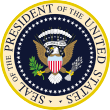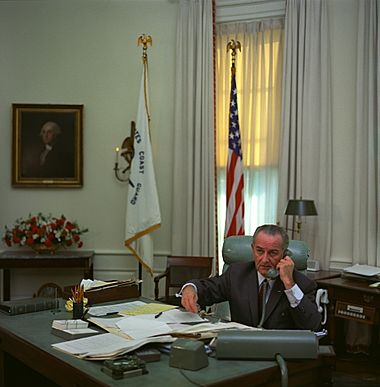Executive Order 11375 facts for kids
| {{#property:P1476}} | |
 |
|

President Johnson in Oval Office
|
|
| Type | Executive order |
|---|---|
| Executive Order number | {{#property:P1555}} |
| Signed by | [[{{#property:P50}}]] on October 13, 1967 |
| Federal Register details | |
| Publication date | {{#property:P577}} |
| Document citation | {{#property:P1031}} |
| Summary | |
| Banned discrimination on the basis of sex in hiring and employment in both the United States federal workforce and on the part of government contractors | |
Executive Order 11375 was a special rule signed by President Lyndon B. Johnson on October 13, 1967. This order made it illegal to treat people unfairly based on their sex when hiring or employing them. This rule applied to jobs in the United States government and for companies that worked with the government.
Why Was This Order Needed?
When the Civil Rights Act of 1964 was being created, it aimed to stop unfair treatment based on race, color, religion, or national origin. At first, the word "sex" was not included. Some lawmakers wanted to add "sex" to the list. One of them was Representative Howard W. Smith from Virginia. He had supported women's rights for many years.
However, some people worried that adding "sex" would make the bill too controversial. They thought it might stop the whole Civil Rights Act from passing. Even some groups that supported women's rights, like the American Association of University Women, were against adding "sex" at that time. But in the end, a group of lawmakers voted to include "sex," and the bill passed with it.
After the Civil Rights Act became law, the people in charge of enforcing it mostly focused on unfair treatment based on race. They didn't always take sex-based discrimination as seriously. For example, the Equal Employment Opportunity Commission (EEOC), which was supposed to enforce the law, even allowed job ads to be separated into "Help Wanted Male" and "Help Wanted Female" in 1965. They said it was for "the convenience of readers."
Many people were upset that unfair treatment based on sex was still allowed. Because of this, groups like the National Organization for Women (NOW) were created in June 1966. They wanted to fight for women's rights.
Franklin D. Roosevelt, Jr., who led the EEOC, said that because "sex" was added to the law late, the EEOC didn't have clear instructions on how to handle it. NOW and other women's groups asked President Lyndon B. Johnson to make government rules stronger against sex discrimination.
On the day President Johnson signed Executive Order 11375, John W. Macy. Jr., who led the Civil Service Commission, shared some facts. He said that about one-third of the complaints his agency received about unfair job practices came from women. However, women made up only a small part of the federal workforce in higher-paying jobs. For example, out of 23,000 jobs paying $18,000 a year, only 658 were held by women.
What Did the Order Do?
This Executive Order added "sex" to the rules against discrimination that were already in President Johnson's earlier order, Executive Order 11246. That order, signed in 1965, covered discrimination based on race, color, religion, or national origin.
Executive Order 11375 went further than other laws at the time. For example, the Equal Pay Act of 1963 only applied to certain types of jobs. But this new order covered people in administrative, executive, and professional roles. Also, unlike Title VII of the Civil Rights Act, it did not leave out teaching staff.
The order said that the Civil Service Commission (CSC) would start hearing complaints about sex discrimination from federal government employees one month after the order was issued. One year later, the Bureau of Labor was given the power to investigate and handle similar complaints from people working for government contractors.
How Was the Order Enforced?
Women's groups, especially the Women's Equity Action League (WEAL), worked hard to make sure lawmakers and government agencies followed through on this order.
On June 9, 1970, the Labor Department released detailed rules for the Executive Order. It said that a government contractor was any business with a government contract worth $50,000 or more and 50 or more employees. The Labor Department's Office of Federal Contract Compliance (OFCC) would make sure these rules were followed.
The new rules made it illegal to advertise job openings under "male" and "female" headings unless a person's sex was truly necessary for the job. They also banned limiting specific jobs or seniority based on sex.
Even though the Labor Department had a main role, every federal agency that gave out contracts was responsible for making sure its contractors followed the OFCC rules. The Labor Department chose the Department of Health, Education, and Welfare (HEW) to oversee colleges and universities. HEW found that there were big differences in how much men and women were paid and promoted in higher education. So, they created a special division to investigate complaints against colleges.
The issue of unfair treatment in higher education became so clear that Congress later addressed it in the Education Amendments of 1972. This important law is known as Title IX.
The OFCC rules also asked for "goals and timetables" to fix past unfair hiring practices. However, government officials were slow to apply these to sex discrimination, even though they did for race. On July 25, 1970, Secretary of Labor James Day Hodgson told women's rights advocates that "employment problems of women are different." He said sex discrimination was "subtle and more pervasive" than against other groups.
In response, women's groups held protests in many cities. A few days later, Hodgson tried to explain his comments. He agreed that "goals and timetables" for sex discrimination were a good idea in principle. But he said the methods used for other types of discrimination were not enough for the "more difficult and elusive problem of sex discrimination." He explained that many women do not look for jobs, unlike almost all adult men. He also said that women had not sought many jobs that racial groups did. He promised to meet with interested groups soon.
Under this Executive Order, the Civil Service Commission also created the Federal Women's Program. This program aimed to help women get jobs and advance in the federal government.
The Executive Order also led to investigations of hiring practices at over 2,000 colleges and universities. This happened after WEAL and NOW filed complaints against 150 schools in 1970. One government official said that about a dozen schools had their funding stopped because they didn't provide employment records. Most of them eventually cooperated.
Dr. Bernice Sandler from the Equity Action League explained how she found out about the Executive Order:
I was reading the 1965 Executive order and happened to see an asterisk. Since I am an academic person, I read the footnote and saw that the order was amended in 1968 [sic] to include women. A eureka-like alarm went off in my head and within months we filed charges against the University of Maryland.
She said her group filed complaints against the California state university system, Columbia University, and others. Investigations were also active at Harvard University, Loyola of Chicago, and George Washington University.
By the late 1970s, the Carter administration used the rules from Executive Order 11375 against large companies like Uniroyal. This company had separate manufacturing areas for men and women. Most companies went to court to try and stop the government from checking their hiring. Only General Dynamics and United Airlines agreed to settle.

